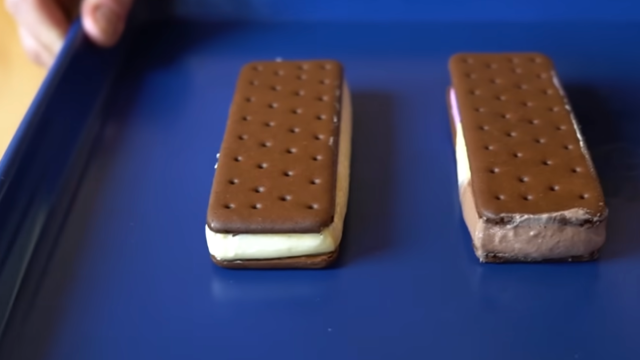The Real Reason Walmart’s Great Value Ice Cream Sandwiches Never Melt

An ice cream cone that never melts sounds like a dream: You wouldn’t have to worry about it dripping on a hot summer day, or making a mess in the car on the way home from the grocery store. But while the concept sounds nice in theory, it’s a bit disconcerting when you buy regular ice cream and realize it stays surprisingly firm after being left out for hours. That’s what some customers have discovered about Walmart’s Great Value ice cream sandwiches, which don’t seem to lose their shape—even in 80-degree heat. Read on to find out the real reason why.
RELATED: Walmart Shoppers Say Never Buy Great Value “Ever”—Here’s Why.
Social media users say Great Value ice cream sandwiches don’t melt.
Social media users recently called attention to the fact that Great Value (Walmart’s generic brand) ice cream sandwiches aren’t threatened by warmer temperatures. Videos posted on TikTok show several Walmart shoppers testing out the theory that these products don’t melt like expected, leaving them out of the freezer for hours at a time.
In a video posted on Jan. 25, TikToker @joeywellness leaves a vanilla Great Value ice cream sandwich out on the counter at room temperature overnight.
“Unfortunately, it didn’t melt after sitting on the kitchen counter for over 13 hours,” @joeywellness says in the video. “Not a single drop, not a single leak.”
But while @joeywellness found that the product looked pretty much the same after half a day, in another video posted by Stephanie Duran (@stephynannas) this week, the ice cream sandwich flattened and yellowed after four hours.
RELATED: Walmart and Target Anti-Theft Measures Could Be “Final Nail in the Coffin,” Shoppers Say.
One YouTuber says they “melt,” but not in the way you’d expect.
YouTuber Emmeline Mayline “Emmy” Cho (@emmymade) also posted a video on Feb. 17 comparing the Great Value vanilla and Neapolitan-flavored ice cream sandwiches with those from Hood and Klondike.
Like other experimenters, Cho left one group sitting at room temperature for over two hours, but she also upped the stakes a bit, putting another group in a preheated oven at 84 degrees Fahrenheit for an hour.
Those that were left at room temperature looked pretty much the same, but all four that were in the oven changed a bit. The Klondike bar was closest to Cho’s expectations in terms of traditional “melting,” but the Hood and Great Value options “don’t behave the way you think an ice cream would.” The Great Value sandwiches, in particular, had settled and came out more like melted marshmallows.
“The ice cream bars do melt, they just don’t melt in the way that you might expect. They do get very soft, but they don’t puddle necessarily,” she explains in the video.
RELATED: These Are All the Walmart Locations Closing Forever This Month.
Walmart previously attributed the melting rate to the cream content.

While some on social media are hearing about the non-melting ice cream sandwiches for the first time, it’s been a question from consumers for the last decade.
Cho states at the beginning of her YouTube video that she heard about this theory roughly nine or 10 years ago—and around that time, Snopes actually looked into why Great Value ice cream doesn’t melt in the traditional sense.
In 2015, a representative for Walmart told the fact-checking outlet that the melting rate of the Great Value ice cream sandwiches has to do with the cream content. Ice cream melts slower when it has more cream, which is the case with Great Value ice cream, the representative said.
Best Life reached out to Walmart for comment on Great Value ice cream sandwiches, and will update this story when we hear back.
The lack of melting could also be due to certain additives.

But while Walmart cited cream content at one point, the real culprit for the non-melting ice cream might be added gums.
According to Snopes, gums like mono-diglycerides are often added to ice cream. These help control the melting rate and prevent crystal formation that occurs when ice cream goes in and out of the freezer.
The Great Value ice cream sandwiches have mono-diglycerides on their ingredient list, as well as cellulose gum and carob bean gum. Both cellulose gum and carob bean gum thicken the ice cream, giving it texture and helping it keep its shape.
One TikToker, @tgpietila, noted that the Yuka app—which analyzes the health impact of cosmetic and food items based on their ingredients—highlights both cellulose gum and mono-diglycerides as “moderate risk” additives in the Great Value ice cream sandwiches.
However, the U.S. Food and Drug Administration (FDA) deems mono-diglycerides, cellulose gum, and carob bean gum (which is also in the ice cream sandwiches) as safe for consumption. Yuka labeled carob bean gum (or locust bean gum) as a risk-free texturizing agent in @tgpietila’s video.
- Source: FDA: Food Additive Status List